After a blisteringly energy-packed sets-hair-on-fire Book Camp 2, the O’Reilly’s Tools of Change #toccon publishing conference in New York rolled forth on February 14-16. I gave an author’s-view keynote on February 15 called ‘The Publishing Pie,’ which you can see at:
It’s a new experience for me, speaking to techfolk- they’re so sharp their brains poke through their skulls like the pins in the Scarecrow of The Wizard of Oz — but they were kind and indulgent and showed me some new toys. In particular, Pablo Francisco Arrieta from Columbia showed me the picture he drew of me on his Ipad, which you can see below.
Most intriguing for me are the apps that can be used to draw, colour, and paint, and I think I will test some out, though crayons, watercolours, pencils and pens are more my usual speed.
I hand-drew the PowerPoint pictures, some of which you can see below; though for context and the right order I’m afraid you have to look at the video, because no matter what I do I can’t get the slides to line up in this blog the way I want them to. 😦 The book covers include Double Persephone (1961), done with a linoblock carving and a flat-bed press (re: self-publishing!); The Circle Game (1966), done with Letraset and stick-on red legal dots; and Up in the Tree (1978), which I hand-lettered in two colours only, to save money in those early days of Canadian childrens’-book publishing, and which is now out again in a facsimile edition from Groundwood Books (Anansi).
Meanwhile I am at work on the Dead Author T-shirt – two colours, I feel – and will post a link here when it’s done and available on Café Press.
The conference itself was a swirl of ideas- they’re multiplying like amoebas in a well-stocked petrie dish – but the short message is: The book is not dead. Reading is not dead. The human interest in stories is not dead. But we are in the midst of a sea change in transmission tools, the likes of which we have not seen since the Gutenberg print revolution. As with that historical moment, there was a lot of turmoil, and nobody could foresee all the consequences.
(NB: Have now supplied altered Elvis & Hendrix slide, removing the offending ‘Jimmy,’ for which I just got poop. Never COULD spell. It’s Jimi, silly bat. With an i.)




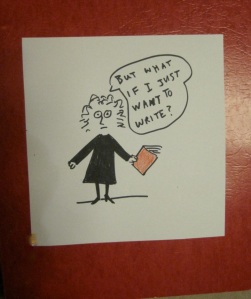
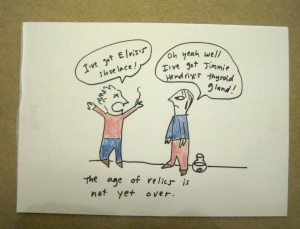



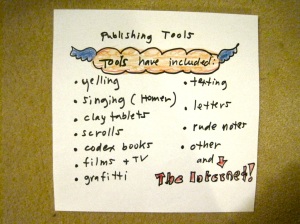
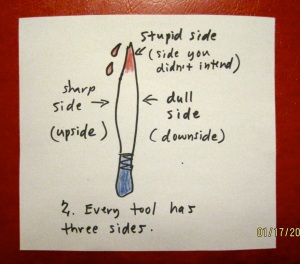
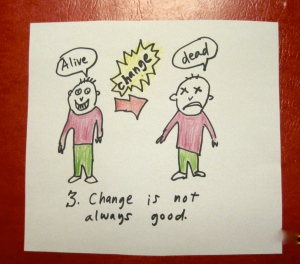

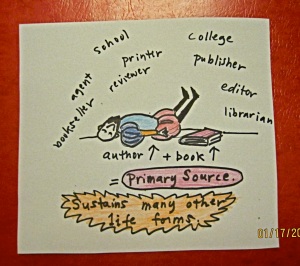
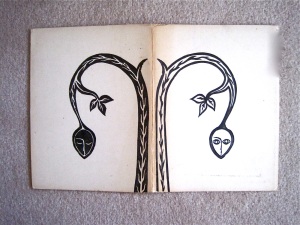
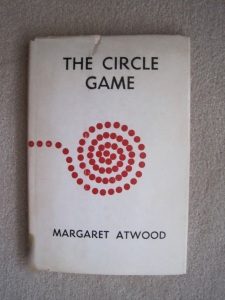
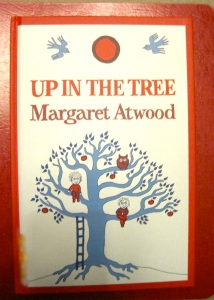

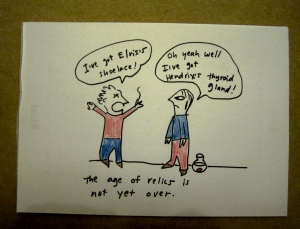
Pingback: FEBRUARY 20 – WEEK 101 RESULTS | Causes of high cholesterol Blog
I liked the Up The Tree picture. Great professional looking print. It reminds me of my graphic design homework assignment where I have to design a book cover. Why not do art, since it’s impossible to make a living as a writer in Canada. Incidentally my old writing teacher sent me a link to a contest today, which I promptly deleted. Life is too short to waste your time on sh*t like that. If you really want to get published, then all you have to do is pay a vanity press to print it for you. No need to enter a stupid contest.
Long live the moose! I’m not an expert in moose biology but a translator, one of those symbiotic organisms without which no author would be digested outside its own language niche. I have deeply enjoyed the presentation and would like to know more about the group of editors that are somehow replicating UA’s experience. Can you redirect me to the post that mentions them?
It seems to be authors, not editors (yet). I scribbled some notes in back of notebook — will try to find. Meanwhile you might like to check out the Neal Stephenson – Greg Bear experiment in a sort of serial subscription, already up online…
Thanks for the moment,
Delia
Writing and talking visually – great cartoons and use of powerpoint.
I noticed the frequent use of the word ‘transmission’ in describing the new tools. The big difference I think is that these tools do not just transmit the authors’ words, but as well readers respond and feed back in a way never before possible. Writers have to ‘face’ their readers, which is also a scary thought.
On another subject: are you familiar with your genealogy? Enid Dogett? My mother swears she is Carl’s cousin but cannot really explain the connection. Let me know if you have any information.
Thank you, Susan. Brain-to-brain transmission has taken many forms. Reader feedback was common in the mid 19th C, when authors published in “numbers” (few chapters at a time — this morphed into magazine serials) and authors such as Charles Dickens altered the story accordingly. When the tool was Oral Story-telling, audience feedback was immediate. (Rotten tomatoes, golden coins, etc.) “Facing” the audience meant just that: face forward!
And yes, Enid Doggett was related to Carl — second cousin, I think. My mother used to go and visit her. I don’t know the exact relationship but somebody must!
So the shy author hiding in their attic producing words is more of a 20th century thing? Today’s authors are going back to that ‘public’ space where they had to face their audiences? Will that cut out the shy author and increase the return of storytellers who are showmen?
On bookselling (also an endangered species) and ebooks take a look at my daughter’s blog:
http://charlotteashley.wordpress.com/category/adventures-in-bookselling/
Thank you for your funny, inspiring talk. I’m an new author, successfully handselling my 2 independent-press novels in Saturday signings in Waterstone’s stores. Waterstone’s is the only UK book chain left slugging it out with Amazon and ebooks. They are closing 10% of their branches after a disappointing 2010. If they collapse, so does this route for a new author with no marketing budget to get known.
It’s always been a mix of “public” authors and “private” authors” — and ones publishing under other names. Dickens and Dylan Thomas were noteworthy performers, Jane Austen and T.S. Eliot were not. It’s been more public in the 20th-21st C than at any other time since bards, as coffee house readings, then university ones, then bookstore ones, then Festival ones proliferated.
So social media is a different kind of publicness, but which also seems so time-consuming to keep up with. I know the internet seems to occupy so much of my time – doing things like posting to blogs! Takes away from writing time, but seems valuable because it contributes to a public conversation.
Oh, my this is brilliant. Thank you so much for sharing. (I have extended its reach by also sharing on Twitter and Facebook.) And now I must go have a cheese sandwich. To toast or not to toast–that is the question.
Re: the cheese sandwich: toast, definitely. If you can afford the heating power. 🙂
Oh, and on the topic of brain transmissions, a recent interview I did with the poet/artist Carloyn Kreiter-Foronda might interest you. We talk a lot about art as conversation, and even mention you. (Turns out we’re both fans.) http://www.rkvry.com/blog
Mary, yes! As you said: “at first it is simply the artist talking to him-or-herself until there is someone on the other side of that art, enjoying it, experiencing it, or even hating it. But in a sense art takes two brains to be fully realized–the creator’s brain and the experiencer’s brain.” Thanks for the link.
Thank you so much for coming to TOC. Your presence took the conference to a whole new level and was the highlight for me. Excited for the tshirt! Will it have both moose and bard images (pleaseplease)? And will the two colors be red and blue? 😉
I almost hate to admit this, but I just now discovered you ( and your glorious sense of humor) by way of the 33 min. video of your presentation at the TOC Conference – posted by Mary Akers, on Facebook, nonetheless. Of course I had to look up your bio right away, too :~)
And now, you have my interest…and I’ll be following your blog…but, which of your books would you suggest for me to read as a first-read?
Thanks Kathy — as for book, depends what you like… Many start with The Handmaid’s Tale.
I second that suggestion. I read it at age 19 and it took the top of my head off.
Really enjoyed the TOCCON, especially this presentation 🙂
Look forward to delving deeper into the Mongoliad as well as an update on that group of independent authors.
Thanks! Here is the group of independent authors: a publishing collective:
“Mischief and Mayhem is a publishing collective, not a publishing company. Our goals are to nurture and promote distinctive authorial voices, especially those that fall outside of commercially acceptable notions of literature, and to do everything we can to bring those writers to the largest possible audience.” I think you can find it at mischiefandmayhembooks. The driving force appears to be Dale Peck.
I am so happy to see your illustrations, they are lovely! I especially liked “publishing pie” and “dead moose” 🙂
Wonderful talk. We’ve been self-publishing for years and doing well but every once in a while a person talks about interviews set up by the publisher and I think oh, wouldn’t THAT be nice.
So glad we share at least a name.
PS I’m only putting this comment on because I can’t figure out how to follow your blog without leaving a comment and clicking on Send me site updates.
And to think I used to be a programmer.
Pingback: BOTNS #117: Who will buy Margaret Atwood’s Cheese Sandwich? | Books on the Nightstand
Read with interest that you drew these on powerpoint which makes you a genius too!
Not a genius! Drew on paper, photographed, used Iphoto … clunky, but maybe I will learn something sharper soon..
Your final paragraph couldn’t be more truthful. Things are changing in the publishing world and writers like myself look to take advantage of it.
I like the idea of a piece of writing sustaining so many people.
The only fear I have of change in publishing is if the alphabet is changed. As long as I can read the instructions on how to open the ‘book’all is well.
I love writing… i try writing, but when i do, everyone tells me its a piece of junk. I don’t believe them, so i just keep writing. I’m actually working on a book, but i don’t expect to finish it any time soon 😉
Neat visuals! Glad you shared these works!
Patricia
Favourite one is the one about wanting to write!
I don’t entirely trust digital drawing. It just makes things too easy and I am regularly tricked into thinking a “digitally enhanced” image is art.
Sneaky.
Keep mashing pigment into paper.
Margaret, you are my new hero. WordPress “pressed” this today and that’s why I’m over here. Unfortunate for me, I’m just now finding your blog and I wish I had known about it before. Fortunately, your presentation has been one of the most exciting things I have seen today and I just love your dry sense of humor! I am in the publicity business but I am an author, too. In fact, that’s where I got my start and it was back in 2004 even when I realized things were changing or maybe that’s when I realized it and it’s been changing for years and I didn’t know it. When I came to the party, print-on-demand was a new buzz word. I didn’t go that route but found a small press which I’m very happy with but since joining the publicity world, I’ve seen all kinds of ways of getting your book published and just as many ways of how to sell said books. I am with you when you say “Publishers don’t have the resources or they quite don’t know how” when it comes to hitting all the bases when it comes to selling books.” What I have found is that for the unknown author, a virtual book tour is the best route to take. Have you ever heard of them?
Welcome! Yes, I have heard of many a virtual booktour scheme.. in fact the original pen-on-paper-book LongPen was a pioneer in that direction, back before e-books. But books have always been like a message in a bottle — the bottle is thrown into the sea, and maybe it will land on a shore where it can be read, and maybe not. Many a frail vessel has gone to the bottom… There is so much luck involved. But as I started in small publishing, I am always thinking of ways to improve the odds…
I have an I-pad, but my sketches don’t look anything like that.
I also have wasted a lot of time struggling to get photos to line up right when embedded in the text.
Contests on being freshly pressed.
love your illustrations ~ but yeah things are changing!
Pingback: Tools of Change: The Publishing Pie, February 15, 2011 (via Margaret Atwood: Year of the Flood) « My Writing Life
Some insightful thoughts about the relationships between writer and reader – thanks for posting them. Just how that relationship will evolve, though, is indeed in change as you point out. I am not sure that it can necessarily be predicted. Inevitably, the way we envisage the future going does not quite pan out (“where’s my flying car, dude?”). Just as video and DVD didn’t kill the going-to-the-cinema experience, I doubt that e-books will kill print. Certain sorts – yes. Those disposable pulp fiction dribblers you have to be trapped on an aircraft to read will almost certainly be relegated to electrons. But larger-format material? Picture books? I doubt it. There is a tactile experience to reading a well-made book that the screen just doesn’t reproduce. Not yet. Maybe not ever.
Matthew Wright
http://mjwrightnz.wordpress.com
http://www.matthewwright.net
I had no idea that you had a blog. I read The Handmaid’s Tale when my sister was studying it for her high school English exam. By the way you write really well about futuristic nightmares e.g. the pigoons in Oryx and Crake. As for me, I am trying to break into the editing industry in Australia. But if writing is going to be all about cutting out the middleman, I see a very negative prognosis for my future!
I understand authors might be the form of our sustenance but the thing is our established models of publishing practice kind of put us in the position of an investment company. We can with our limited resources only back those authors whose ‘stock’ remains high or we run the risk of going bankrupt… like Red Group Retail has in Australia.
Pingback: Tools of Change: The Publishing Pie, February 15, 2011 (via Margaret Atwood: Year of the Flood) | The Calculable
Pingback: Tools of Change: The Publishing Pie, February 15, 2011 (via Margaret Atwood: Year of the Flood) «
Pingback: The Current History of the Future of Publishing: Margaret Atwood speaks at the Tools of Change conference « Samuel Snoek-Brown
This made me chuckle..Thank you so much for sharing
Dear Margaret,
as one of those strange 10% of ‘making a living’ authors, once anyway, I wonder if you’d dip into Phoenix Ark and tell us if some kind of dream to fight back, to become a platform by giving a free online novel, as it’s written, or cultural essays, or little films, is simply nuts. The dream is to found a publisher in London that protects and connects disconnected authors, but are we not of a breed naturally competative and often disconnected, except with the hope of our own readers? You wouldn’t contribute a short cultural essay would you?!
Kind regards,
David Clement-Davies
Dear Margaret, many thanks for the thoughtful post and conference talk which I was able to read, view and enjoy online! Moments like these clarify the rich possibilities of the internet. Online publishing gives readers the opportunity to find writers coming from places and perspectives they might never have encountered otherwise. And equally, it offers writers the possibility of reaching readers who might never have discovered their work through more traditional journals and books.
Having said that, we have become so easily accustomed to the idea that the internet is ‘free’ that I find myself, as both a reader and writer, sometimes balking at paying a subscription for an online journal; something which I would never do when buying a paper copy of Brick or Orion magazine for example. Does the presence of a book, its physical qualities, lend it value? Of course the quick answer is no – it’s the quality of the writing within that is of value, of and beyond the monetary. But in an online world increasingly unwilling to pay for its culture – downloaded films, songs, books – I sometimes wonder if the book, that beautiful marriage of the imaginative and the tactile, is deemed of greater value as a thing, something substantive and enduring. Regardless, and despite its difficulties, it remains an exciting age for the written word. Many thanks again and best wishes,
Julian
These are really good drawings 🙂 Thanks for sharing.
great
visit
http://simymir.wordpress.com/
I like this http://to.ly/9tEg
I have to be honest and say those were over my head. And now I feel like the last one laughing. :oD Oh well, at least I’m laughing.
Margaret – I enjoy following your blog and have chosen it for the “One Lovely Blog Award.” You may pick up the award to display on your site @ http://ponderdeeply.blogspot.com/2011/02/impact-of-tiny-impression.html
P.S. Your parenthetical mini-anecdote about Jimmy vs Jimi gave me a good chuckle – thank you :~)
Thank you Kathy! And thank you for the award. I am so inept I don’t know how to transfer it.. 😉
Pingback: Everyone loves pie: Margaret Atwood and the changing face of publishing « Eagle Creek Writers Group
I am a person like you — I’m in the middle.
I prefer traditional paper books as I love the texture and quality and I also like e-books [I find it hard to be on one extreme as some once posted correctly; it’s like telling someone to choose between sunsets and candy or something along those lines]
Keep up the great job and writing! ^_^
Pingback: Tools of Change: The Publishing Pie, February 15, 2011 (via Margaret Atwood: Year of the Flood) « slices of ink
First of all: I’m so excited that Margaret Atwood — MARGARET ATWOOD!! — has a blog on WordPress!
Now that I’m done jumping around and squealing like a teenage girl at a boy-band concert, I want to thank you for posting the video of your presentation. Thank you for pointing out what is painfully obvious to writers but seems to be completely lost on the mega-imprint publishing conglomerates: without authors, there will be nothing to publish.
I am greatly encouraged by the re-emergence of small presses and publishing collectives. Technology has shifted the economies of scale so that smaller, more agile publishing enterprises can once again compete, especially in niche markets. More publishing enterprises means more opportunities for authors, and the growing recognition of self-published work expands those opportunities even further.
Thank you, too, for noting that the overall quality of work in publication at any given time has always been mixed. Publishers are businesses, and as such are understandably more interested in what sells than in what constitutes good writing. A book may or may not sell as well as it is written, depending on how it is marketed. I wish people kept this better in mind.
And congratulations on being Freshly Pressed!
Hi, i’m just wondering what your social media policy is?
Thanks,
hilary
Um, what do you mean? I’m not sure I have a ‘policy.’ Could you give me an example of one?
Dear Ms. Atwood:
American or Swiss?
Ah. The cheese. I’d say whatever you can get.
Pingback: Margaret Atwood & Cheese Sandwiches — If Authors Starve, Look Who Else Starves, Too « The Scholarly Kitchen
Well written Write-up. Glad i am able yo locate a site with some knowledge plus a great writing style.
You keep publishing and i will continue to Keep browsing
Thanks Again
I’m lucky! I saw your speech live at TOC. It made the whole conference have more relevance for me. And the “alive-change-dead” slide was perfect! Thanks! Ps. Finished Oryx and Crake today. Had actually read Year of the Flood first. The out of order-ness worked wonderfully for me. Loved it! when’s the next?
Hello, Ms. Atwood:
You had mentioned that you would post in your next blog the name of the “United Artists” like author’s co-op that you talked about in your Tools of Change keynote (which was delightful, by the way!). I looked through your blog and these comments — but I’m either blind, or it’s late (and perhaps a tad, but only a tad, lazy), and haven’t found this reference. Would you be willing to post (or re-post, if I’ve missed the reference)?
Many thanks,
Dave
Hi Dave: Check out this one: http://dalepeck.com/2009/10/16/or-booksmischief-and-mayhem/ Started as a writers’ collective, has just morphed into a publishing company. (Which is what happened with UA: started as a group of screen artists who then formed their own studio.) There is also of course the possibility of skipping the group formation and e-publishing and also paper-publishing yourself, and a number of writers have done well with that.) I have also heard various rumbling bits of shop talk that indicate other people are thinking of alternate methods.
I ❤ You Ms Atwood
(Your works are pretty good to)
🙂
Pingback: Communication vs Validation: why are you publishing? | Jo VanEvery
Hello Margaret,
Thank you so much for your talk. I have posted it on my blog and quoted you as well on the whole state of publishing…
Here is the pingback link:
http://www.thearrglingtonjump.com/jump-here.htm
[“… we are in the midst of a sea change in transmission tools, the likes of which we have not seen since the Gutenberg print revolution. As with that historical moment, there was a lot of turmoil, and nobody could foresee all the consequences.”]
And also, you rock!
Pingback: Margaret Atwood On Publishing – Novelr - Making People Read
So sensible. So clear. Thank you. If you step back far enough, it’s exciting watching a change like this. It’s like watching a huge tidal wave rearing up while the people on shore scurry around at their normal business, some going so far as to put on rubber boots. There is a deluge forming in communications, in the written word, but just as the survivors of the tsunami must go on breathing and eating come what may, writers can comfort themselves with the knowledge that future readers must go on consuming writing. In that there is a certain basic security. Because the world at large will continue to need them, it must be assumed it will find a way to provide them with their necessary cheese sandwiches. I would go further and say that since writing is a fully consuming job in itself that does not leave time to also be an editor, a publicist, a contract lawyer, an accounts clerk, a programmer etc, the future will also require an infrastructure around writing–call it publishing or call it some new thing–to nurture, distribute and collect money for writing. So I think the future, when it gets sorted out, will have places for most of the personnel it does now, with maybe a little retraining needed for booksellers and printers. That’s the long term. The short term is a little more disturbing. With everybody’s books being being stolen through the a-hole and given away free on Pirate Bay, there will almost certainly be some near-term disruption of the cheese sandwich supply. Keeping in mind that it only takes 40 days for a healthy human to starve to death and that most writers are pretty skinny to start with, there could definitely be some very unpleasant scenes to be played out before governments wise up and provide the primary producers of words with the kind of conditions they need to survive. Certainly here in Canada, Bill C-32 reveals our government still moving in the wrong direction.
Pingback: Panicked Ranting in eBooks « Inklings
Thank you for your funny, inspiring talk. I’m an new author, successfully handselling my 2 independent-press novels in Saturday signings in Waterstone’s stores. Waterstone’s is the only UK book chain left slugging it out with Amazon and ebooks. They are closing 10% of their branches after a disappointing 2010. If they collapse, so does this route for a new author with no marketing budget to get known.
Pingback: April 2011 |
Pingback: What can writers learn from rock stars? (video) | Laura E. Kelly | Laura E. Kelly
Hi Margaret,
Thank you for your many years of exceptional writing and a great talk. It was so interesting to hear about the publishing world – then, now and soon – from your unique perspective. Loved the illustrations too! Hopefully, many of us will emerge through this transition un-dead. Look forward to following your blog and reading more of your books…
Pingback: Tools of Change: The Publishing Pie, February 15, 2011 (via Margaret Atwood: Year of the Flood) |
Pingback: The era of Chinese e-books… « Voices under the Sun
Pingback: Long live the moose! « Voices under the Sun
Dear Margaret,
I love your books. You are by far the most eloquent author I have read. I was moved by the Edible woman beyond words.
I don’t know if you read these… I sure hope you do.
My name is Lacy. I am a young mother trying to start a small permaculture farm on Pelee Island. I don’t know if you are interested in hearing about our idea/plan. But if you would like to find out more about our dream I have a blog post here http://vancampenurbanhomestead.wordpress.com/putting-a-dream-out-there/. I have a finished business plan if you are interested. If you are not, thanks for your time.
Thanks
Hello Lacy: I’ve Tweeted your site… good luck with it… Have you shared it with the Pelee council and the Heritage Centre? There are a number of people who would be interested in knowing….
Very best, Margaret